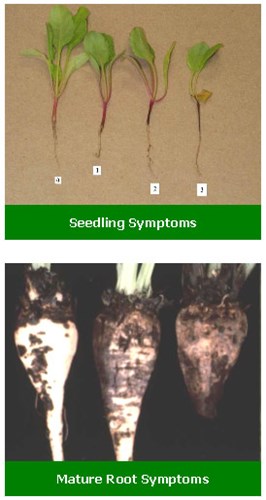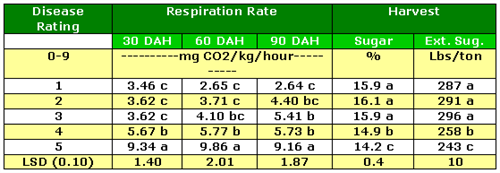538 - Root Disease Management: Rhizoctonia
Rhizoctonia is one of the most serious diseases of many commonly grown field crops in Minnesota and North Dakota. It infects sugarbeets, soybeans, corn and dry edible beans in the Red River Valley. It also infects many of the common weeds, eq pigweed, lambsquarters and kochia. The disease is caused by the soil borne fungus Rhizoctonia solani.
Recognizing Rhizoctonia Symptoms

Seedling Stage
Rhizoctonia can cause seedling damping off very early in the growing season. The seedling disease can be preemergence or post emergence but is most commonly observed post emergence. Seedling stage starts below the soil surface, progresses up the hypocotyl and often causes seedling death.
Mature Plant Symptoms
Foliar blight on leaves and petioles is rarely observed in Minnesota and North Dakota. Crown rot consists of infection starting above or at the soil level. Petioles rapidly wilt, turn black, and become prostrate on the soil surface with a "spider like appearance". Another form starts as a root tip rot and moves upward. Both forms cause severe wilting of the plant. Another symptom becoming much more common is a root rot starting a few inches below the soil line. When this form occurs the leaf canopy does not wilt and die in most cases. Root rot phases commonly begin in June or July and sometimes August.
About Rhizoctonia
- Caused by a soil borne fungus
- Spread by any means of infected soil transport
- Survives in soil for many years
- Warm to hot temperatures and wet soil favor disease
- Once infected plants do not recover
Economic Impact
Yields losses can be negligible if few plants are infected. However 50% or more yield loss can occur with severe infestations. Fields with very severe infestations will not be fit for storage and these fields will be abandoned. Rhizoctonia can be found in virtually all fields in the RRV.

Rhizoctonia Control Measures
- Plant resistant varieties
- Apply fungicides in a timely manner
- Provide good field drainage
- Eliminate row crop cultivation
- Eliminate rotary hoe use
- A minimum 3-year rotation is necessary
- Control susceptible weeds
- Follow wheat or barley in rotation
2009 Rhizoctonia / Storage Trial - Crookston, MN Campbell and Fugate, USDA, Fargo, ND

HELP IS AVAILABLE:
Contact your agriculturist for assistance with variety selection or fungicide rates and timing.
Photos - Thanks to Dr. Carol Windels, UM and Bill Niehaus ACSC for photographs
